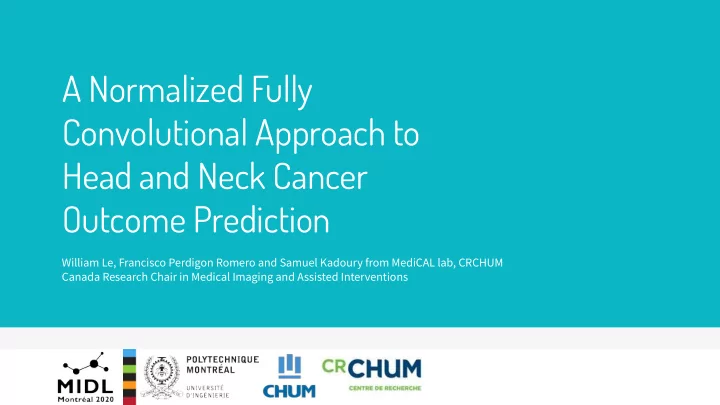

A Normalized Fully Convolutional Approach to Head and Neck Cancer Outcome Prediction William Le, Francisco Perdigon Romero and Samuel Kadoury from MediCAL lab, CRCHUM Canada Research Chair in Medical Imaging and Assisted Interventions
Treatment context and 2 medical imaging data Diagnosis Planning Treatment Follow-up FDG PET-CT Planning CT (Chemo-)Radiotherapy 43 months (6-112) Preprocessing ▹ 3D → 2d using max GTV area CT ▹ Isotropic resampling to 1×1 mm Deep ▹ Resizing to 128×128 Convolutional ▹ Normalizing PET to SUV Neural Data Augmentation (x20) Network PET ▹ Flip 50% probability 298 H&N ▹ Shifu up to 40% cancer patients ▹ Rotate up to 20 degrees [1] Vallières, M, et al. (2017). Data from Head-Neck-PET-CT. The Cancer Imaging Archive.
3 Proposed model [1] Xie, Saining, et al. "Aggregated residual transformations for deep neural networks." Proceedings of the IEEE conference on computer vision and pattern recognition , 1492-1500 (2017). [2] Drozdzal, M. et al . Learning normalized inputs for iterative estimation in medical image segmentation. Med. image analysis 44, 1–13 (2018).
4 Training and Evaluation Characteristics Alive / Deceased SeLU activation as regularizer/normalization ▹ 83:18 CHUS Training Residual connections to improve convergence rate ▹ Aggregated convolutions for model capacity regularization Validation ▹ FCN as an target-oriented image-to-image domain ▹ 197 samples (5:1) 77:14 HGJ translation or image normalizer Implementation 60:5 CHUM Test PyTorch using GeForce RTX 2080 TI ▹ 101 samples Categorical cross-entropy loss ▹ 22:19 HMR 1:8 resampling to combat data imbalance ▹ Adam optimizer: 0.0006 lr ▹ Batch size: 8 ▹ Dataset augmented 20 times ▹ Total epochs: 100 (1 hour) ▹ [1] Vallières, M. et al. Radiomics strategies for risk assessment of tumour failure in head-and-neck cancer. Sci Rep 7, 10117 (2017).
Survival binary classification 5 prediction results AUC PET CT Masked CT PET-CT (Spec, Sens) 59% 57% 67% 65% 930,146 parameters CNN¹ (90%, 29%) (37%, 77%) (82%, 52%) (99%, 30%) 59% 65% 63% 70% 1,321,682 parameters FCN+CNN (41%, 77%) (51%, 79%) (35%, 90%) (69%, 71%) 50% 65% 69% 74% AggResCNN 291,874 parameters (100%, 0%) (54%, 76%) (51%, 87%) (66%, 82%) FCN+AggResCNN 57% 70% 67% 76% 683,650 parameters (ours) (21%, 94%) (46%, 94%) (52%, 82%) (61%, 91%) [1] Diamant, A., Chatterjee, A., Vallières, M., Shenouda, G. & Seuntjens, J. Deep learning in head & neck cancer outcome prediction. Sci. reports 9, 1–10 (2019).
6 Conclusion 1. Our proposed CNN model improves over the state-of-the-art for head and neck cancer survival outcome prediction (76% > 65%). 2. Incorporating PET imaging information improves model performance. 3. Our proposed architectural change (FCN, aggregated residual connections) benefit model performance without incurring a larger model complexity cost. 4. The addition of the FCN improves performance when coupled with more complex input features (CT, PET-CT).
Recommend
More recommend